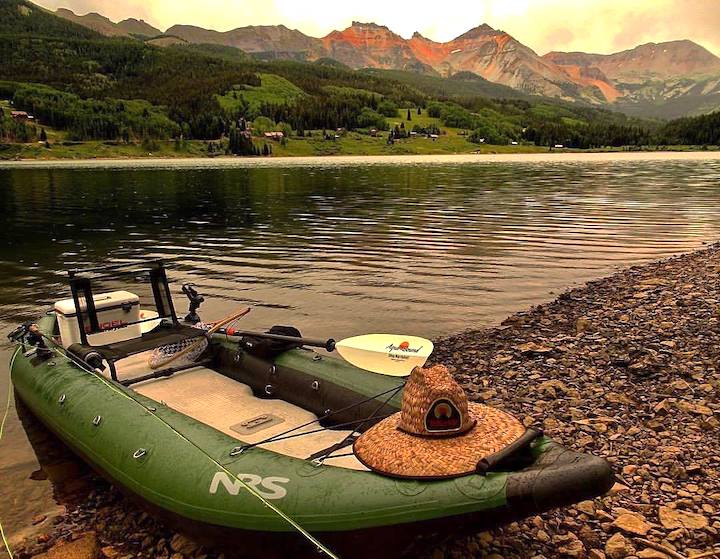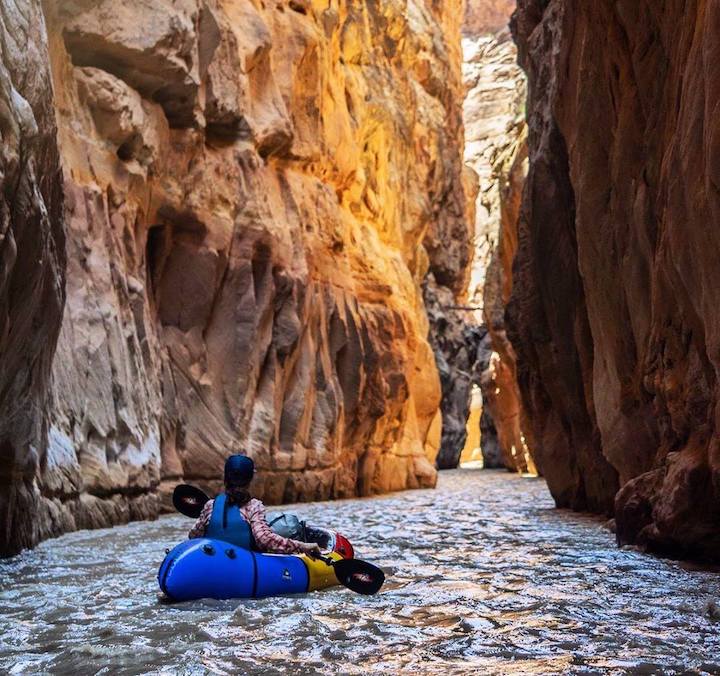Inflatable Kayaks 101: What to Know

High-end inflatable kayaks are a great option for paddlers (photo courtesy of Telluridic)
Inflatable kayaks have been increasing in popularity in the past couple of years. What should you know about them so you can make a good buying decision? Let’s take a look at a few of the main factors.
Should You Buy an Inflatable Or a Hardshell Kayak?
This is the first question you’ll want to answer. The main advantage of an inflatable, which could make or break your decision—is that it’s much easier to transport and store than a hardshell kayak.
If you live in an apartment, a single room or even a dorm room you may not have anywhere to store a hardshell kayak. But an inflatable can fit in a closet or be kept in your vehicle’s trunk.
If you’d rather not have to hoist a hardshell kayak to the roof of your vehicle and tie in on, it’s much easier to fit an inflatable in your trunk or backseat. And it really doesn’t take any more time to inflate and deflate an inflatable kayak than it does to get a hardshell up on your vehicle and strap it down.
Inflatable kayaks weigh much less than a hardshell kayak of the same size. That makes it easier to haul back and forth to the water, put it in your vehicle and bring it to wherever you’ll store it.
How Much Should You Spend on an Inflatable Kayak?
We’ll take you over to a very informative video by Jake Baikoff on choosing an inflatable. This 20-minute video goes over the differences between the cheapest, mid-range and high-end inflatable kayaks.
Keep in mind that in the inflatable kayak world, as in most other things, you get what you pay for. If you’re going to kayak a handful of times a year in relatively safe local waters, you can spend less. You can find them at box stores and some online retailers for less than $100 up to $250 or so.
We recommend going with a known kayak brand that’s sold at a paddle sports retailer. The sales staff at those retailers know kayaking, and will be able to fit you with a boat that’s right for you, your needs and your budget. These will be more mid-range, $250-800, and up. They use better, tougher materials than the lowest-end boats.

Mid-range inflatable kayaks are versatile recreational boats (photo courtesy of @amandaw0830)
If you want to be able to take your inflatable on rapids, bigger water and longer excursions, you definitely want to go high-end—$1,000 or more. They’re constructed of the most durable and longest-lasting materials. Better kayaks will have more durable valves for inflating, as well as options to replace or repair them.
Some cheap inflatable kayaks come with a paddle—a heavy, clunky paddle. No matter what kind of kayak you get, it’s worth it to invest in a lightweight, responsive paddle that’s the right length for you and your boat. You’ll enjoy your paddling experiences much more!
See our Kayak Paddle Sizing Guide.
Inflatable Kayaks Come in Both Single and Tandem Models
Just like hardshell kayaks, inflatables are available in single and tandem models. Will you do most of your paddling alone? A single will do just fine.
Do you want to paddle a lot with a spouse, friend, child or large dog? Then a tandem is probably your best bet. Be sure and check each model’s weight limits before deciding which one to buy.
Disadvantages of Inflatable Kayaks
Inflatables can be a hassle to dry after paddling. While hardshell kayaks need outdoor, garage or shed storage, it’s fairly easy to dry them out, often right in their storage spot. Even if they don’t dry immediately, they’ll dry eventually because they’re out in the open.
And inflatable kayak needs to dry out, too, before you fold it back up and put it away. Because there are more places that need to dry, it could take longer. You’ll want to take out anything that can be removed, like the seat and floor, in order for it all to dry thoroughly.
You’ll need some space to leave it until it’s dry. If you pack it up wet, you’re likely to end up with mold and mildew eventually.
Cheaper inflatables are squishy and soft. This makes them harder to get in and out than a hardshell kayak because you don’t have the same leverage. This is especially true with the sit-inside models.
The high-end models inflate much tighter and give better support for both sitting in the kayak and getting in and out of it.
Have You Heard of Packrafts?
Packrafts are inflatable, too, but are designed for backcountry expeditions and are, therefore, extremely packable and lightweight. A one-person packraft can weigh under 10 pounds, and roll up and fit in a backpack along with your other gear.

Packrafts are tough, versatile and super packable (photo courtesy of @brettrdavis)
They’re also extremely tough and able to carry quite a load for a boat so small. A growing niche within the packraft community is bikerafting—a combo of mountain biking and packrafting.
You don’t need a pump with a packraft. Instead they rely on a nylon bag to inflate them. If you’re looking at an inflatable kayak in the mid-range or up, you may also want to consider a packraft. They start at about $600.
See What’s So Cool about Packrafting?
Have questions about choosing a kayak paddle? Contact our friendly Customer Service team today: 715-755-3405 • sales@aquabound.com
More for you...





